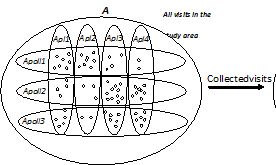A method for under-sampled ecological network data analysis: plant-pollination as case study
DOI:
https://doi.org/10.26786/1920-7603(2011)18Abstract
In this paper, we develop a method, termed the Interaction Distribution (ID) method, for analysis of quantitative ecological network data. In many cases, quantitative network data sets are under-sampled, i.e. many interactions are poorly sampled or remain unobserved. Hence, the output of statistical analyses may fail to differentiate between patterns that are statistical artefacts and those which are real characteristics of ecological networks. The ID method can support assessment and inference of under-sampled ecological network data. In the current paper, we illustrate and discuss the ID method based on the properties of plant-animal pollination data sets of flower visitation frequencies. However, the ID method may be applied to other types of ecological networks. The method can supplement existing network analyses based on two definitions of the underlying probabilities for each combination of pollinator and plant species: (1), pi,j: the probability for a visit made by the i’th pollinator species to take place on the j’th plant species; (2), qi,j: the probability for a visit received by the j’th plant species to be made by the i’th pollinator. The method applies the Dirichlet distribution to estimate these two probabilities, based on a given empirical data set. The estimated mean values for pi,j and qi,j reflect the relative differences between recorded numbers of visits for different pollinator and plant species, and the estimated uncertainty of pi,j and qi,j decreases with higher numbers of recorded visits.

Downloads
Published
How to Cite
Issue
Section
License
Copyright (c) 2012 Peter B. Sorensen, Christian F. Damgaard, Beate Strandberg, Yoko L Dupont, Marianne B Pedersen, Luisa G. Carvalheiro, Jacobus C. Biesmeijer, Jens Mogens Olsen, Melanie Hagen, Simon G Potts

This work is licensed under a Creative Commons Attribution 4.0 International License.
JPE is an open access journal which means that all content is freely available without charge to the user or his/her institution.
Authors who publish with this journal agree to the following terms:
1) Authors retain copyright and grant the journal right of first publication with the work simultaneously licensed under a Creative Commons Attribution License that allows others to share the work with an acknowledgement of the work's authorship and initial publication in this journal.
2) Authors are able to enter into separate, additional contractual arrangements for the non-exclusive distribution of the journal's published version of the work (e.g., post it to an institutional repository or publish it in a book), with an acknowledgement of its initial publication in this journal.
3) Authors are permitted and encouraged to post their work online (e.g., in institutional repositories or on their website) prior to and during the submission process, as it can lead to productive exchanges, as well as earlier and greater citation of published work (See The Effect of Open Access).
To assure a broader targeted audience, content will be included into databases (such as EBSCO) and directories (such as DOAJ).











